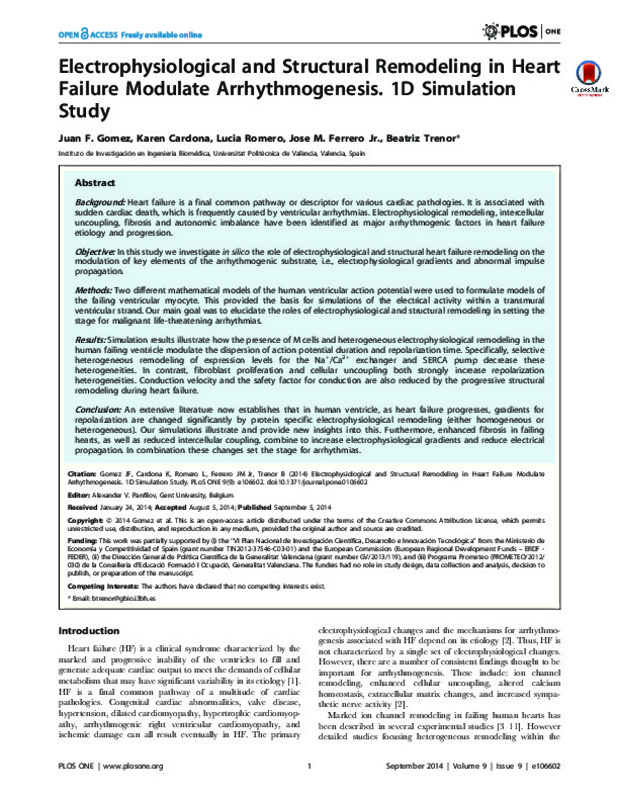|
Resumen:
|
Background: Heart failure is a final common pathway or descriptor for various cardiac pathologies. It is associated with
sudden cardiac death, which is frequently caused by ventricular arrhythmias. Electrophysiological ...[+]
Background: Heart failure is a final common pathway or descriptor for various cardiac pathologies. It is associated with
sudden cardiac death, which is frequently caused by ventricular arrhythmias. Electrophysiological remodeling, intercellular
uncoupling, fibrosis and autonomic imbalance have been identified as major arrhythmogenic factors in heart failure
etiology and progression.
Objective: In this study we investigate in silico the role of electrophysiological and structural heart failure remodeling on the
modulation of key elements of the arrhythmogenic substrate, i.e., electrophysiological gradients and abnormal impulse
propagation.
Methods: Two different mathematical models of the human ventricular action potential were used to formulate models of
the failing ventricular myocyte. This provided the basis for simulations of the electrical activity within a transmural
ventricular strand. Our main goal was to elucidate the roles of electrophysiological and structural remodeling in setting the
stage for malignant life-threatening arrhythmias.
Results: Simulation results illustrate how the presence of M cells and heterogeneous electrophysiological remodeling in the
human failing ventricle modulate the dispersion of action potential duration and repolarization time. Specifically, selective
heterogeneous remodeling of expression levels for the Na+
/Ca2+ exchanger and SERCA pump decrease these
heterogeneities. In contrast, fibroblast proliferation and cellular uncoupling both strongly increase repolarization
heterogeneities. Conduction velocity and the safety factor for conduction are also reduced by the progressive structural
remodeling during heart failure.
Conclusion: An extensive literature now establishes that in human ventricle, as heart failure progresses, gradients for
repolarization are changed significantly by protein specific electrophysiological remodeling (either homogeneous or
heterogeneous). Our simulations illustrate and provide new insights into this. Furthermore, enhanced fibrosis in failing
hearts, as well as reduced intercellular coupling, combine to increase electrophysiological gradients and reduce electrical
propagation. In combination these changes set the stage for arrhythmias.
[-]
|
|
Agradecimientos:
|
This work was partially supported by (i) the "VI Plan Nacional de Investigacion Cientifica, Desarrollo e Innovacion Tecnologica" from the Ministerio de Economia y Competitividad of Spain (grant number TIN2012-37546-C03-01) ...[+]
This work was partially supported by (i) the "VI Plan Nacional de Investigacion Cientifica, Desarrollo e Innovacion Tecnologica" from the Ministerio de Economia y Competitividad of Spain (grant number TIN2012-37546-C03-01) and the European Commission (European Regional Development Funds - ERDF - FEDER), (ii) the Direccion General de Politica Cientifica de la Generalitat Valenciana (grant number GV/2013/119), and (iii) Programa Prometeo (PROMETEO/2012/030) de la Conselleria d'Educacio Formacio I Ocupacio, Generalitat Valenciana. The funders had no role in study design, data collection and analysis, decision to publish, or preparation of the manuscript.
[-]
|









